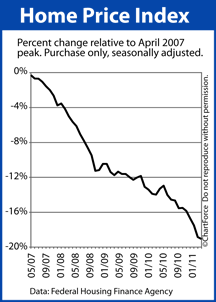 Home values dropped for the sixth straight month in March 2011, according to the Federal Home Finance Agency’s Home Price Index. The Home Price Index is a government-sponsored home value tracker.
Home values dropped for the sixth straight month in March 2011, according to the Federal Home Finance Agency’s Home Price Index. The Home Price Index is a government-sponsored home value tracker.
The HPI report is the latest in a string of “falling home values” stories — a trend that’s troubling home sellers across Minneapolis and nationwide.
However, although the Home Price Index says home values are falling, that doesn’t necessarily mean that they are. Like most statistics in the housing sector, the Home Price Index is plagued by poor methodologies and a lack of timeliness.
In short, the Home Price Index is flawed. In three ways.
The first big flaw in the Home Price Index is that it only measures the values of homes with mortgages backed by Fannie Mae or Freddie Mac. Homes financed via FHA, or via other means are specifically excluded from the calculation. For today’s purchase market, that leaves more than 1 in 4 homes “uncounted” — a big percentage of the market.
Second, the Home Price Index determines home values by measuring price change from sale to subsequent sale. This eliminates new homes — a major market segment.
And, lastly, the Home Price Index reports on a 60-day delay; we’re only now seeing data from March. This two-month lag renders the HPI a trailing indicator for the housing market instead of a forward-looking one. If you’re a home buyer looking for market insight, the HPI can’t give it — it’s out-dated and out of season.
Despite its shortcomings, though, we can’t ignore the Home Price Index completely. It’s among the most thorough home valuation models available, and it’s used in public policy discussions. When the HPI says prices are down, Wall Street and Capitol Hill take notice, and that trickles down to everyday life on Main Street.
Since peaking in April 2007, the Home Price Index is off 19.1 percent.

Leave a Reply